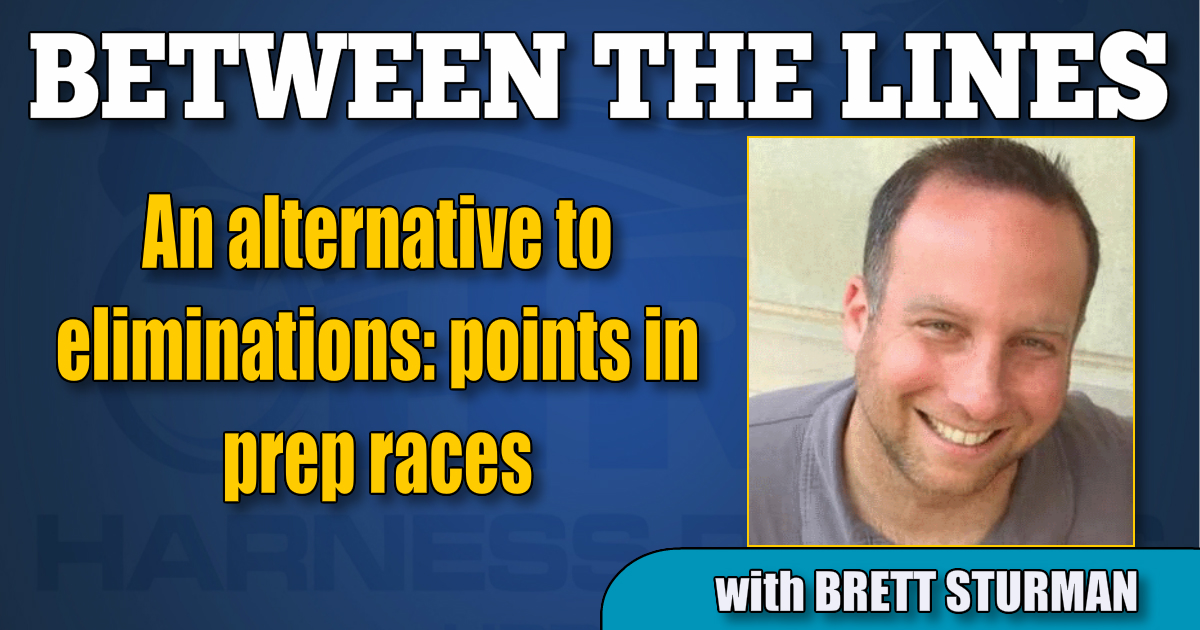An alternative to elimination races for major stakes
Instead of eliminations, what if horses accumulated points in assigned prep races for major races such as the Hambletonian, Meadowlands Pace and Breeders Crown?
by Brett Sturman
Beginning the middle of next month, the first stakes payments become due for most stakes races to take place later this year. That, in turn, begins to form the basis for the horses that could eventually declare into those races, which in the case of most premier stakes would be in an elimination race.
If there’s one thing that most people can agree on, it’s that elimination races aren’t particularly appealing to anyone. As a bettor, there’s little incentive to participate in the races and an argument can be made that they should be made non-betting. With the primary objective of the elimination simply being to make the final and not necessarily win the elimination, there’s usually a lack of optimum effort by drivers and horses in these races. And for the connections of the horses, there is little incentive to come in first (so as long as they qualify for the final) considering that the purse of the elimination race may only be five per cent of the purse of the final race.
Way back when, it was somewhat different when eliminations for the Meadowlands Pace had 30 horses entered and the eliminations were far more competitive, knowing you needed to finish in the top three out of 10 to make the final. Today, the horses entered in a number of these races are sparse and to make the final out of an elimination you only need to finish in the top 5 most of the time. Like the Meadowlands Pace, which had only 15 horses enter in 2019, the Hambletonian had only 16 horses enter. What it meant is that if you didn’t finish in second-to-last or third-to-last in your elimination, you’d be in the final.
As an alternative, a points system could be established as to determine what horses race in a stakes final for races such as the Meadowlands Pace, Hambletonian, or even the Breeders Crown races. Modeled from what’s used in the thoroughbreds to determine which horses can race in the Kentucky Derby, horses could accumulate points based from the current stakes schedule on the harness racing calendar.
For example, let’s take the Hambletonian. Some 3-year-old trot races that precede the Hambletonian on the racing calendar include the Dexter Cup, the Goodtimes, the Earl Beal, the Landmark at Goshen, the Stanley Dancer, and so forth. Each of these races would award a varying degree of points to top finishers from those races, and the horses with the highest accumulated point totals would be the ones that race in a final.
Through that process, horses would have to earn their way into the Hambletonian final by how they perform in key designated races throughout the year. Races such as the Goodtimes and the Beal would carry more weight than the Dexter Cup because of the difference in quality of fields between those races, but all would play some role in assigning points towards the Hambletonian. In that sense, it would benefit the race as a whole because it would create a true “Hambletonian trail” that would last throughout much of the year inclusive of real buzz and suspense. Each week could have a role in which horses are trending to get in and which one’s need more work to do.
In addition to the Hambletonian sticking with that race as the example, all races from the other tracks that serve as “prep” races would benefit greatly in the process as well. Today, the Currier & Ives at The Meadows attracts only so much attention as a race on its own, but it surely would take on even more significance if it had direct Hambletonian implications. Same goes for sire stake finals from different states if those were chosen to be included as well. And further, the prep races wouldn’t need to be limited to only 3-year-old races. Horses could start accumulating points through races in their 2-year-old season such as the Peter Haughton or the Breeders Crown.
This may seem like a radical idea, but it wouldn’t be the first time that something similar has been put into practice. I recall back around 10 years ago or so when Harrah’s Chester ran their “Super Sunday” races that included the Battle of Brandywine, The Colonial and The Valley Forge, they took a different approach to traditional eliminations.
In those races, they ran a final and consolations for each race that were determined solely by earnings. In a year where the Battle of Brandywine went for $500,000, there was also a consolation 1 that went for $200,000 and a consolation 2 that went for $100,000. How horses got entered into which race was determined by highest earners. This proposal would essentially represent the same type of process, only instead of using earnings there would be a slightly different criteria using points. As long as owners have been making sustaining stakes payments, horses would be assured of at least being entered into one of the races should they declare at time of race entry. The end result would be a set of races where all of them would be competitive, as opposed to how it is today when only the final is consistently competitive.
Admittedly, such a process would only work for the biggest races and the ones that take place later in the year so that there are enough sufficient prep races for horses to earn points. But, the idea seems like something worth exploring as there would be a positive impact for all races and all tracks involved. The end result would be more exciting races.

















